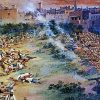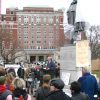
KJIPUKTUK (Halifax) – This year marks the 10th annual rally against the U.S.-led Halifax war conference, the Halifax International Security Forum (HISF) on November 16-18, held in the context of the centenary of the ending of the First World War and the world “peace forum” of the big powers in Paris. This “forum,” involving high-profile generals, admirals, defence ministers, ideologues and corporate executives from the NATO bloc, will discuss “issues of international security.” According to the Department of Defence, which has doled out some $30 million tax dollars to the U.S. organizers for funding since 2009, the aim of the “discussion” is to “learn from each other, share opinions, generate new ideas, and put them into action” (emphasis added). One particular topic, “100 Years On: Are We Tired of Winning?,” is a telling implication of the real agenda.
In 2009 the Harper government handed over $2.9 million Canadian tax dollars in an unsourced four-year contract to the German Marshall Fund of the United States (GMFUS), based in Washington, totalling $9.96-million to stage the first HISF. The NATO bloc was a “partner”. The origins of these arrangements are murky and kept in the shade, which indicates the transparency and governance practised under the high ideals of democracy. Not until 2014 – and only as a result of Access to Information requests – did the public glean some information as to the financial arrangements between DND and Washington.
In its statement issued in July 2009, the same month that NATO launched its review towards updating its “security doctrine,” [1] GMFUS President Craig Kennedy called it “a step in the process of changing the conversation” about Canada’s role in the ‘trans-Atlantic community,’ toward a recognition of its being a top-tier power in its own right that is worthy of a seat at the table with the globe’s most powerful war-fighting nations.”
It is worth revisiting statements by then Foreign Minister Peter MacKay, a sometime candidate to become NATO Secretary General. He stressed that the aim of his government in funding the HISF was to create a supranational agency “at arms length” that would specifically promote the global expansion of NATO beyond its traditional sphere and the responsibilities of Europe and Canada in that direction, rather than NATO merely being “about Europe.” An immediate aim of the United States in 2009 was to build a consensus amongst Canadian and European elites on continued military participation in America’s ignominious “long war”: Afghanistan.
The message was clear: as the new Cold War was breaking out, Canada’s transformation to a counterinsurgency-capable expeditionary force and its contribution to the war in southern Afghanistan had allegedly earned it the respect of NATO’s key power, the United States, which, in turn, was going to boost its global profile among other NATO allies and give it a bigger share of the pie. This disinformation seeks to imbue Canadians with a chauvinist outlook, which portrays Canada as a major power fit to sit at the table that divides the spoils of war.
Why Halifax of all places?
Why here? Why Halifax of all places? Despite the use of the name of our city, this forum has no organic connection with Halifax. The U.S. organizers have never come clean, except to assert that it is all being done in the name of democracy and “trans-Atlantic values” – by which is meant the union of Europe under the U.S. banner.
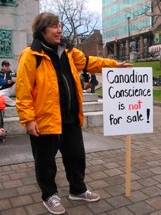
For their part, successive New Democrat and Liberal premiers have personally welcomed this forum to the city as the opportunity to sit at the table with the imperialists and compete to divide the benefits from expanding the spoils of the war economy. However, while the ruling elite secures a place for themselves as yes-men, wthe movement of the people against war persists.
Today, the vested interests continue to propagate the disinformation of the First World War that, in the words of the Halifax Board of Trade, “Halifax booms in times of war, declines in peacetime.” The message is clear: Haligonians are enthusiastic about living in a militarized city due to the “benefits” of the war economy. This is cited as the “reason” why people should applaud the Halifax Forum. They are treated as benign and routine activities over which the people have no control, as Halifax and Canada are already integrated into the U.S. war machine and Fortress America.
This is entirely self-serving. It covers up that this has been at the dictate of the British and American empires, at the expense of the brutal subjugation of the Indigenous Mi’kmaq people, the exploitation of workers, sailors and the youth, who are offered “no life like it” as cannon fodder as the alternative to going down the road. They were not enthusiastic, to say the least, for their city to be virtually destroyed by the horrific Sixth of December explosion of 1917 and the Bedford Magazine explosion of 1945, nor today by the grave threat posed by the continuous visits of U.S. and NATO warships, including the submarines armed with nuclear ballistic missiles.
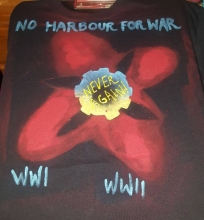
There has been little enthusiasm among the warmongers to tell the truth about the peoples’ resistance during and to the First World War and since then, in order to justify war today. The general strike of May 1, 1919 of 3,000 construction workers against war profiteering is rarely if ever mentioned in the scores of accounts of the Halifax Explosion. This elite requires a pacified population, especially of the most decisive social force, the working class and in particular, port workers who have historically frustrated shipments of war materiel in numerous ports around the world, including Saint John, NB. The reality is that there were many small and large acts of resistance which have continued in Halifax to date.
The United States itself has always paid first-rate attention to this reality, as shown by the declaration of the Pentagon in 1983 of CFB Shearwater as an “advanced forward base” of the U.S. Strategic Air Command, amongst other measures. Or take the fact of the December 1, 2004 “visit” of U.S. President George W. Bush to Halifax; here, rather than to the parliament, he choose to give his only speech in Canada during his presidency.
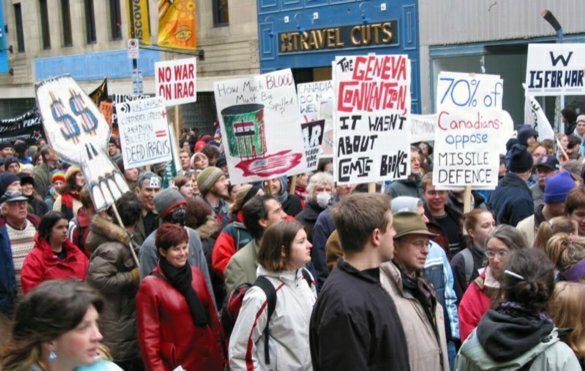
The political establishment has never been able to wrap its head around the reality that an estimated 7,000 Nova Scotians marched to oppose Bush’s “visit” – an exceptional number in this, a strategic NATO base and the most heavily militarized city in Canada. They declared to Bush, “Not In Our Name!” As a result, the media went so far as to suppress all photos indicating the immensity of the turnout, and instead marginalized and demonized the people as “pot smokers.” Attempts over the years to undermine people’s conviction – to convert this movement into a lobby group or to declare it is “dead” – have failed despite the concerted efforts of the establishment forces to do so.
Part 2 of a series on the annual Halifax war conference, written by Tony Seed for the Nova Scotia Advocate.
See also Part 1: All out to oppose the annual US-led war conference in Halifax
Next: 10 years of the US-led Halifax war conference, 10 years of opposition.
2018 Anti-War Rally: Saturday, November 17 — 1:00 pm
With a special thanks to our generous donors who make publication of the Nova Scotia Advocate possible.
Subscribe to the Nova Scotia Advocate weekly digest and never miss an article again.


